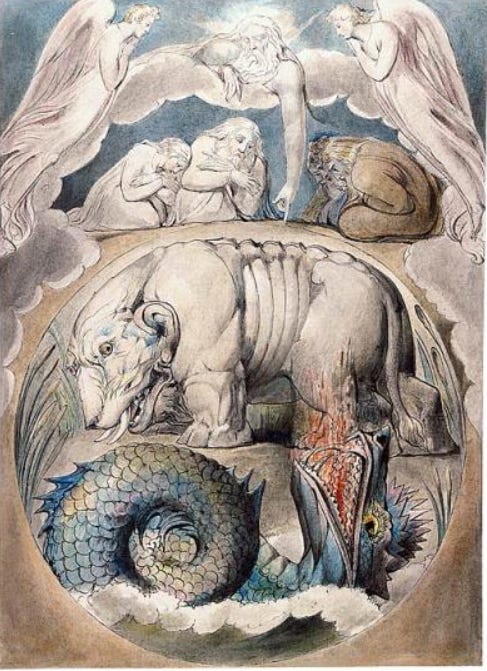The Tao of Job, Pt. II
Tantric Buddhism vs. the Book of Job
This is a follow-up to the essay below.
The Tao of Job
I’ve been revisiting books of the Bible thanks to my boy Glen Rockney. We covered the Book of Exodus on a crossover episode of Rare Candy and Agitator (listen below), and will soon be doing the same …
The Book of Job and Tantric Buddhism serve up different philosophies on suffering—one through faithful surrender to divine mystery, the other through alchemical transmutation of pain into wisdom. But both challenge conventional dualities of pain and pleasure, of good and evil. I’m obsessed with struggle ‘cause it’s all I’ve known, and as a family man with ambition who’s working on building a better life, I’ve been tryna rewire my brain to internalize a healthier relationship with the struggle. This is probably finna get real schizophrenic, ‘cause I have no interest in presenting a clear thesis of intellectualized mystic whatever-the-fuck. If you tryna intellectualize God and shit, you are probably going to hell, amigo.
I just want to dump it all on the table, see what we’re working with.
So here goes.
Suffering in Job is framed as a cosmic test, an invitation to encounter the Wild God, the God who responds to his broken creation’s pleas of understanding with, “Bitch, I created the Leviathan! You seen a Behemoth? Yeah, that was me!” (Job 41)
This is William Blake’s depiction of God’s Leviathan and Behemoth, drawn sometime in the early 1800s:
Off rip, everything I know about Tantric Buddhism is from listening to Threshold Saints. I only learned of it in talking with Jin the Ninja and listening to his podcast. There are books I have glimpsed at and will probably never finish that you can read if you’d like. Reading is good. I’m too superstitious and don’t want the shit to not work for me ‘cause I “understand it too much.” But go with Tao. Here’s some of those books:
Stephan Beyer — The Cult of Tārā: Magic and Ritual in Tibet
Sogyal Rinpoche — The Tibetan Book of Living and Dying
Jerome Edou — Machig Labdrön and the Foundations of Chöd
Sarah Harding — Machik’s Complete Explanation: Clarifying the Meaning of Chöd
Tsongkhapa — The Great Treatise on the Stages of the Path
In Tantric Buddhism, suffering (dukkha) arises from clinging to illusions (ego, permanence, dualities). It’s different from donut shop Buddhism or Oprah Book Club Buddhism or the other mainstream Buddhisms (Theravāda, Mahāyāna), which are all about transcending suffering. Tantra is about alchemizing the struggle, about using adversity as fuel for awakening. Pain is not recognized as something evil, but as primordial awareness (rigpa), an empty energy to meditate on.
If Job were a Tantra practitioner, he’d have internalized his suffering—done the dance with shakti and harnessed that energy—instead of allowing it to remain externally imposed on him by God and Satan.
Another way Tantric Buddhism could have helped Job is in his attitude of protest vs acceptance. Job snaps at God in Job 7:20, “If I have sinned, what have I done to you, you watcher of men? Why have you made me your target? Have I become a burden to you?” Raw honesty coupled with his blind faith ends up leading Job into collision with divine wonder that he is eventually rewarded for enduring, what if all that fighting was unnecessary?
Instead of directing anger outward, like Job does, the Tantric practice would be to dissolve it into wisdom. In Tantra, all emotions—even anguish and despair—are embraced as divine energy. Yamantaka is a Buddhist deity most famously known as the Destroyer of Death. He represents overcoming all obstacles, even negative karmic imprints and samsara. These aren’t battles won by force, but by alchemy, by treating poison as medicine. One of the rituals of Chöd is to visualize offering your body to demons, dissolving attachment to pain.
Struggle and bliss contain the same nutrients in the Tantric soup.
I’m almost positive it was Tsongkhapa who related Samsara to Nirvana, referring to the world of pain as the “field of awakening.” In higher forms of Tantra, even karma is seen as an illusion of divine play (lila). The goal of the karmic illusion is to recognize the empty nature of states like suffering, to view suffering not as punishment but as conditioning.
This is one of the key differences between Tantric Buddhism and Abrahamic Gnosticism or Christianity (or even Taoism), where it is understood in the latter three that God transcends morality, that the divine is beyond human notions of justice. Tantric Buddhism dissolves morality completely, to the point there is no dual awareness, no intrinsic good or evil.
The bittersweet, somewhat ambiguous ending of the Book of Job might hint at a turn to Tantric practice for Job. He is bestowed with new blessings, but nothing that was taken from him can be returned. He is scarred. His suffering was integrated, not erased. This mirrors the endgame of Tantra, where liberation is found within the chaos. Where the goal is not restoration, but awakening within suffering. Where pain is realized to be—as all other phenomena—a dream-like display of the mind.
Anyway, y’all be easy.
Pre-order my hoodrat neo-western noir novel Texas Tea and listen to Agitator.




